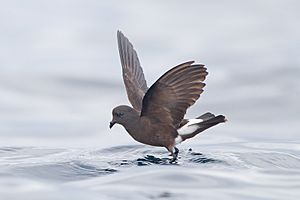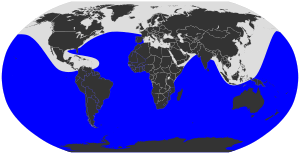Wilson's storm-petrel facts for kids
Quick facts for kids Wilson's storm-petrel |
|
|---|---|
 |
|
| Conservation status | |
| Scientific classification | |
| Kingdom: | |
| Phylum: | |
| Class: | |
| Order: | |
| Family: | |
| Subfamily: |
Oceanitinae
|
| Genus: |
Oceanites
|
| Species: |
O. oceanicus
|
| Binomial name | |
| Oceanites oceanicus Kuhl, 1820
|
|
 |
|
| Distribution range (blue) | |
The Wilson's storm-petrel (Oceanites oceanicus), also called Wilson's petrel, is a small seabird. It is part of the storm petrel family, known as Hydrobatidae. This bird is one of the most common bird species in the world!
Wilson's storm-petrels live all around the globe. They are mostly found in the seas of the Southern Hemisphere. However, they fly north during the summer in the northern hemisphere. Experts believe there are more than 50 million pairs of these birds. This means they are very numerous! The bird is named after Alexander Wilson, a Scottish-American bird expert.
Contents
Amazing Facts About Wilson's Storm-Petrels
What They Look Like
Wilson's storm-petrels are small birds. They are usually dark brown or black. They have a white patch on their bottom, near their tail. Their feet are special because they have yellow webbing between their toes. This yellow webbing helps them move on water.
Where They Live
These birds spend almost all their lives at sea. They fly over the open ocean. They only come to land to lay their eggs. They are often seen far from any coastlines.
How They Fly and Find Food
Wilson's storm-petrels have a unique way of flying. They often flutter just above the water's surface. They sometimes look like they are walking on the water. This helps them pick up tiny food items. They mostly eat small crustaceans and tiny fish. They also eat plankton that floats near the surface.
Reproduction and Life Cycle
Wilson's storm-petrels build their nests on land. They prefer islands in the Antarctic region. They dig small burrows or find cracks in rocks for their nests. The female bird usually lays just one egg. Both parents take turns sitting on the egg. They also share the job of feeding the chick. After the chick grows up, it leaves the nest and flies out to sea.
Images for kids
See also
 In Spanish: Paíño de Wilson para niños
In Spanish: Paíño de Wilson para niños




